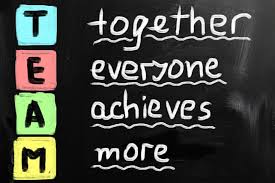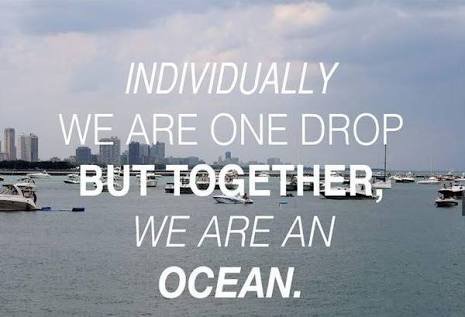TEAM WORK

A 2012 review of the academic literature found that the word "teamwork" has been used "as a catchall to refer to a number of behavioral processes and emergent states.
In healthcare, teamwork is "a dynamic process involving two or more healthcare professionals with complementary background and skills, sharing common health goals and exercising concerted physical and mental effort in assessing, planning, or evaluating patient care.
In a business setting, accounting techniques may be used to provide financial measures of the benefits of teamwork which are useful for justifying the concept. Health-care policy-makers increasingly advocate teamwork as a means of assuring quality and safety in the delivery of services.
Elsewhere teamwork is defined as “those behaviours that facilitate effective team member interaction", with "team" defined as "a group of two or more individuals who perform some work related task, interact with one another dynamically, have a shared past, have a foreseeable shared future, and share a common fate”.
WHAT IS A REAL TEAM?
When talking about teamwork, it is important to first properly define the term "team"—many people think they work in teams when really, they work in so-called pseudo teams—groups of co-workers put together and called a team, but without fulfilling basic requirements for effective teamwork. Basic requirements for effective teamwork are an adequate team size (best seems to be about 6-8 members); a clearly defined and measureable goal (such as the creation of a new product in innovative jobs, a high patient survival rate in healthcare jobs, or customer satisfaction in service-oriented jobs), as well as autonomy, authority and resources needed to fulfil the team goal. Furthermore, roles within the team should be clearly defined.
PROCESSES
Researchers propose that team performance should be seen as a series of input-process-outcome-episodes that are defined as temporal cycles of goal-oriented activities. These episodes consist of action and transition phases. Action phases focus on activities that are directly related to goal achievement, while transition phases focus on the evaluation and/or the planning of activities to guide the goal accomplishment. Within these phases there can be distinguished between ten different processes arranged into three higher-level categories:
Researchers have identified 10 teamwork processes that fall into three categories:
- Transition process (between periods of action)
a. Mission analysis.
b. Goal specification.
c. Strategy formulation. - Action process (when the team attempts to accomplish its goals and objectives).
a. Monitoring progress toward goals.
b. Systems monitoring.
c. Team monitoring and backup behavior
coordination. - Interpersonal process (present in both action periods and transition periods).
a. Conflict management.
b. Motivation and confidence building.
c. Affect management.
Researchers have confirmed that performing teamwork generally works better when members of the team have experience working together due to enhanced coordination and communication. This appears partly due to a chemical called serotonin, which helps an individual to communicate better and think more positively. Serotonin is produced when an individual is in a situation where he/she is in comfortable environment. Teams run more efficiently when the individual members communicate with the other members

DRAWBACKS AND BENEFITS
Some teams, especially those not composed according to the aforementioned standards, may perform poorly, that is, work less effectively than should be expected according to their members’ combined capacities. This is partly due to effects such as social loafing. In addition to that, Group decision-making seems to be less efficient, and creativity can be lower in groups than a combination of individuals’ efforts may be. This is also partly due to process losses, that is, group energy that could otherwise be put into work processes (e. g. creativity, thought processes) is needed for group processes. Even though there are some drawbacks to working in groups, it can also be beneficial. Some groups outperform what would be expected of their members’ combination of skills – these groups experience what is called social labouring (in contrast to social loafing). Social labouring occurs when there is a high motivation to fulfil the task, when there is a strong group identity, and also when members are of non-Western, collectivist cultures.
Problems solving: A single brain can’t bounce different ideas off of each other. Each team member has a responsibility to contribute equally and offer their unique perspective on a problem to arrive at the best possible solution. Teamwork can lead to better decisions, products, or services. The quality of teamwork may be effective by analyzing the following six components of collaboration among team members: communication, coordination, balance of member contributions, mutual support, effort, and cohesion. In one study, teamwork quality as measured in this manner correlated with team performance in the areas of effectiveness (i.e., producing high quality work) and efficiency (i.e., meeting schedules and budgets).
Healthy competition: A healthy competition in groups can be used to motivate individuals and help the team excel.
Developing relationships: A team that continues to work together will eventually develop an increased level of bonding. This can help people avoid unnecessary conflicts since they have become well acquainted with each other through teamwork. Team members’ ratings of their satisfaction with a team is correlated with the level of teamwork processes present.
Everyone has unique qualities: Every team member can offer their unique knowledge and ability to help improve other team members. Through teamwork the sharing of these qualities will allow team members to be more productive in the future.
Increase motivation: teamworking can lead to a high motivation level in a group due to increasing accountability for individual performance. When groups are being compared, members tend to become more ambitious to achieve higher levels of performance and results. providing groups with a comparison standard increases the performance level thus leading to members encouraging each other to work together simultaneously.
In healthcare: teamwork is associated with increased patient safety.
Teamwork may have an "unintended effect of fermenting hostility toward the managerial goal of making the teams fully self-managing." In one case study of a clothing manufacturer, a switch from production line work (with bonuses given for individual performance) to teamwork (in which an individual's earnings depended on team performance) caused workers to resent having to monitor each other.
SPECIFIC FORMS OF TEAMS
Action teams / swift starting teams.
While most teams develop over time and are not expected to perform directly, the term ‘action teams’ refers to teams that are build ad hoc to carry out a specific task immediately. Their members are usually specialists who must work together and often face unexpected events or emergencies (e.g. aviation crews, flight crews, ad hoc teams in healthcare organizations, crisis management teams). In contrast to other teams in the work context, action teams are characterized by low familiarity and no time for typical teambuilding activities. This is even amplified in situations where even after the formation team membership is not stable.
As noted in Input-Process-Output Model a team's work pattern develops over time. One substantial type in this context are early interaction patterns, describing recurrent sets of communication within the team. Research has shown, that more effective action teams are characterized by early interaction patterns that can be described as more stable (enabling a better predictability and coordination) and involve more than one actor (indicating a better information sharing). The quality of work in action teams seems not to be related to the amount of interaction and interaction patterns, but rather its quality.
Top management teams
A top management team (TMT) is a specific form of team which typically consists of some of the top managers in a firm. However, there is no clear definition to what the top management team of an organization is. It is put together by the Chief Executive Officer (CEO) to work on a specific task. In working on this task, the team generally has a much higher responsibility and considerable autonomy than other forms of teams which have already been described.
The way TMTs are put together and work together as a team can greatly differ from other teams. This is mainly based on the fact that top managers have succeeded as individuals which often leads to a focus on functional team objectives rather than to working interdependently on a shared goal. TMTs consist of top managers from different functional areas of the firm, so they usually have different areas of expertise. As we learned, diversity and heterogeneity in teams can have a positive effect on team work. Nevertheless, there are also negative effects which have to be overcome as a team like not valuing different opinions and perspectives. A CEO that models valuing behavior and ensures the team has both a clear purpose and clear objectives can do just that. This also reduces social categorization effects because it leads to team members focusing more on their shared goals than on their differences.
The exchange of information during the working process is as important for TMTs as it is for all other kinds of teams. In order to work effectively, the team needs to understand how to communicate, share information, set goals, give feedback, manage conflict, engage in joint planning and task coordination and solve problems collaboratively. The CEO plays a key role in enabling the team to do so. He or she must take on the responsibility to coach the team and to reflect on their work.
Virtual teams
A virtual team is defined as groups of coworkers that are assembled using a combination of telecommunications and information technologies to accomplish a variety of critical tasks. The coworkers do not have to be dispersed by geographic or organizational circumstances although those factors make it more likely for a team to engage in team virtuality. There are basically three dimensions of team virtuality:
- The extent to which team members use virtual facilities to coordinate or execute team processes.
- The amount of informational value provided by such tools.
- The synchronicity of team member virtual interaction
Every team can be described on a continuum concerning its virtuality, whereas virtuality is defined as the informational value a virtual tool conveys. The second point means that the less valuable information a tool provides, the more virtual it is. This refers to the way of communication as well as to the value of data that is conveyed. Concerning the synchronicity of a team's interaction one can distinguish between real time interaction which is called synchronous exchange of information whereas interaction that contains a time lag between is called asynchronous exchange of information.